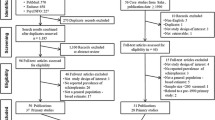Abstract
Background
Results from previous studies on the incidence rates for schizophrenia are inconsistent, with some showing a declining rate [e.g., Suvisaari et al. (1999) Arch Gen Psychiatry 56:733–740] and others showing an increasing rate [e.g., Boydell et al. (2003) Br J Psychiatry 182:45–49].
Objective
This study examines (1) whether incidence rates are changing, (2) relationships amongst changing incidence rates and age, period and cohort effects, and (3) the impact of rate changes on rate projections.
Design
A care-based cohort study carried out in British Columbia, Canada, 1989–1998. Bayesian statistical analyses were used to estimate rates and describe secular effects. Classical tests of significance were used to assess the relative importance of age, period and cohort effects.
Results
Between 1989 and 1998, median rates per 100,000 persons changed from 77.1 (90% credible interval (CI): 42.1–137.7) to 89.9 (90% CI: 80.1–100.1) in females, and from 66.6 (90% CI: 38.8–113.3) to 119.6 (90% CI: 107.4–132.4) in males. Age effects were active for both males and females. Period and cohort effects were stronger for males than females.
Conclusions
In contrast to most previous studies, we found an increasing incidence of schizophrenia. Precise projections of schizophrenia incidence beyond 5 years require large sample sizes over prolonged periods of follow-up.




Similar content being viewed by others
References
Geddes J (1993) Persistence of decline in diagnosis of schizophrenia among first admission to Scottish hospitals. Br J Psychiatry 163:620–626
Osby U, Hammar N, Brandt L, et al. (2001) Time trends in first admissions for schizophrenia and paranoid psychosis in Stockholm County, Sweden. Schizophr Res 47:247–254
Suvisaari JM, Haukka JK, Tanskanen AJ, et al. (1999) Decline in the incidence of schizophrenia in Finnish cohorts born from 1954–1965. Arch Gen Psychiatry 56:733–740
Takei N, Lewis G, Sham PC, Murray RM (1996) Age-period-cohort analysis of the incidence of schizophrenia in Scotland. Psychol Med 26:963–973
Bromet EJ, Fenning S (1999) Epidemiology and natural history of schizophrenia. Biol Psychiatry 46:871–881
Oldehinkel AJ, Giel R (1995) Time trends in the care-based incidence of schizophrenia. Br J Psychiatry 167:777–782
Kendell RE, Malcolm DE, Adams W (1993) The problem of detecting changes in the incidence of schizophrenia. Br J Psychiatry 162:212–218
B.C. Statistics (2002) Population Section, Ministry of Finance and Corporate Relations
Larsen TK, Friis S, Haahr U, et al. (2001) Early detection and intervention in first-episode schizophrenia: a critical review. Acta Psychiatr Scand 103:323–334
Jablensky A, Sartorius N, Ernberg G, et al. (1992) Schizophrenia: manifestations, incidence and course in different cultures. A World Health Organization ten-country study. Psychol Med Monogr Suppl 20:1–97
Iacono WG, Beiser M (1992) Are males more likely than females to develop schizophrenia? Am J Psychiatry 149:1070–1074
Boyd M, Vickers M (2000) 100 years of immigration in Canada. Can Soc Trends 58
Clayton D, Schifflers E (1987) Models for temporal variation in cancer rates II: age-period-cohort models. Stat Med 6:469–481
Berzuini C, Clayton D (1994) Bayesian analysis of survival on multiple time scales. Stat Med 13:823–838
Osmond C, Gardner MJ (1982) Age, period and cohort models applied to cancer mortality rates. Stat Med 1:245–259
Holford TR (1991) Understanding the effects of age, period and cohort on incidence and mortality rates. Ann Rev Public Health 12:425–457
Bashir S, Estève J (2001) Projecting cancer incidence and mortality using Bayesian age-period-cohort models. J Epidemiol Biostat 6:287–296
Bray I (2002) Application of Markov chain Monte Carlo methods to projecting cancer incidence and mortality. J R Stat Soc Ser C Appl Stat 51:151–163
Knorr Held L, Rainer E (2001) Prognosis of lung cancer mortality in West Germany: a case study in Bayesian prediction. Biostatistics 2:109–129
Tsuchiya K, Monk-Jorgensen P (2002) First admission rates of schizophrenia in Denmark, 1980–1997: have they been increasing? Schizophr Res 54:187–191
Preti A, Miotto P (2000) Increase in first admissions for schizophrenia and other major psychoses in Italy. Psychiatry Res 15(94):139–152
Crocetti GM, Lemkau PV, Kulcar Z, et al. (1971) Selected aspects of the epidemiology of psychoses in Croatia, Yugoslavia. 3. The cluster sample and the results of the pilot survey. Am J Epidemiol 2:126–134
Dohrenwend BP (1980) Mental illness in the United States: epidemiological estimates. Praeger Publishers, New York
Harvey CA, Pantelis C, Taylor J, et al. (1996) The Camden Schizophrenia Surveys. II. High prevalence of schizophrenia in an inner London borough and its relationship to socio-demographic factors. Br J Psychiatry 168:418–426
McCreadie RG, Leese M, Tilak Singh D, et al. (1997) Nithsdale, Nunhead and Norwood: similarities and differences in prevalence of schizophrenia and utilization of services in rural and urban areas. Br J Psychiatry 170:31–36
Boydell J, Van Os J, Lambri M, Castle D, Allardyce J, McReadie R, Murrary M (2003) Incidence of Schizophrenia in south-east London between 1965 and 1997. Br J Psychiatry 182:45–49
Acknowledgements
The authors wish to acknowledge Dr. Donald Addington for his comments in reviewing a draft of this paper.
Author information
Authors and Affiliations
Corresponding author
Rights and permissions
About this article
Cite this article
Bray, I., Waraich, P., Jones, W. et al. Increase in schizophrenia incidence rates: findings in a Canadian cohort born 1975–1985. Soc Psychiat Epidemiol 41, 611–618 (2006). https://doi.org/10.1007/s00127-006-0073-z
Accepted:
Published:
Issue Date:
DOI: https://doi.org/10.1007/s00127-006-0073-z




